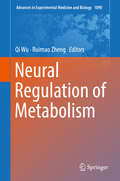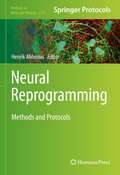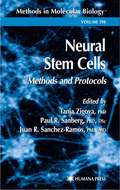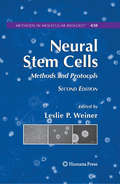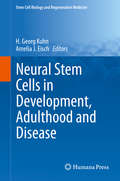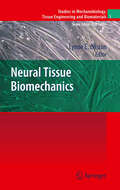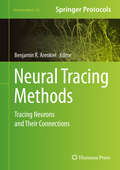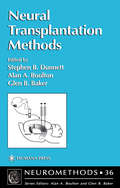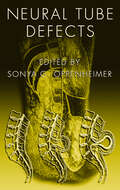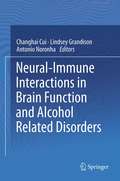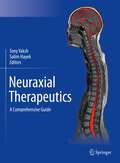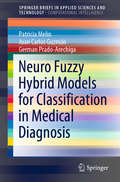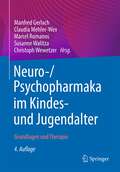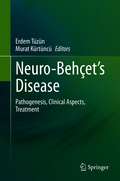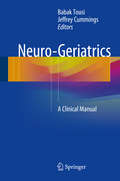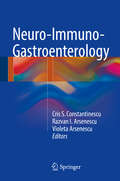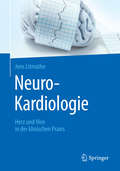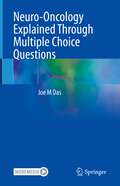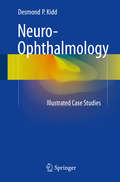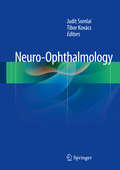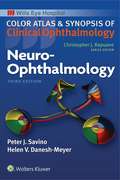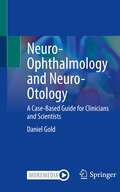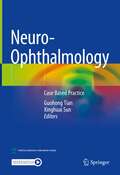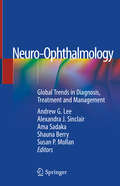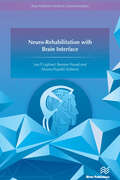- Table View
- List View
Neural Regulation of Metabolism (Advances in Experimental Medicine and Biology #1090)
by Qi Wu Ruimao ZhengThis book systemically describes the mechanisms underlying the neural regulation of metabolism. Metabolic diseases, including obesity and its associated conditions, currently affect more than 500 million people worldwide. Recent research has shown that the neural regulation of metabolism is a central mechanism that controls metabolic status physiologically and pathophysiologically. The book first introduces the latest studies on the neural and cellular mechanisms of hypothalamic neurons, hypothalamic glial cells, neural circuitries, cellular signaling pathways, and synaptic plasticity in the control of appetite, body weight, feeding-related behaviors and metabolic disorders. It then summarizes the humoral mechanisms by which critical adipocyte-derived hormones and lipoprotein lipase regulate lipid and glucose metabolism, and examines the role of the hypothalamus-sympathetic nerve, a critical nerve pathway from CNS to peripheral nervous system (PNS), in the regulation of metabolism in multiple tissues/organs. Furthermore, the book discusses the functions of adipose tissue in energy metabolism. Lastly, it explores dietary interventions to treat neural diseases and some of the emerging technologies used to study the neural regulation of metabolism. Presenting cutting-edge developments in the neural regulation of metabolism, the book is a valuable reference resource for graduate students and researchers in the field of neuroscience and metabolism.
Neural Reprogramming: Methods and Protocols (Methods in Molecular Biology #2352)
by Henrik AhleniusThis detailed book brings together a number of state-of-the-art protocols to generate different types of neural cells through the use of reprogramming technologies. Additionally, the volume explores different aspects of functional evaluation and applications of reprogrammed neural cells as well as in silico methods to aid reprogramming efforts. Written for the highly successful Methods in Molecular Biology series, chapters include introductions to their respective topics, lists of the necessary materials and reagents, step-by-step, readily reproducible laboratory protocols, and tips on troubleshooting and avoiding known pitfalls. Authoritative and cutting-edge, Neural Reprogramming: Methods and Protocols provides ample experimental experience and guidance for anyone, be it experienced researcher or beginner, to generate, validate, and apply reprogrammed neural cells in their research.
Neural Stem Cells
by Tanja Zigova Juan R. Sanchez-Ramos Paul R. SanbergIn Neural Stem Cells: Methods and Protocols, internationally recognized experts from academic, clinical, and pharmaceutical laboratories describe in great detail the most frequently used cellular, molecular, and electrophysiological methods to isolate, characterize, and utilize neural stem cells. These readily reproducible techniques introduce the various sources of stem/progenitor cells, provide a wide range of conditions for their culture, and make it possible to define their properties in culture. Additional techniques are designed to help researchers identify endogenous stem cells as well as exogenous stem cells after transplantation in the brain. The protocols range from the simplest methods of isolation and characterization of neural cell properties to such very sophisticated methods as characterizing gene expression, telomerase assays, and cell cycle kinetics.
Neural Stem Cells
by Leslie P. WeinerMany questions related to stem cell properties and neural stem cell lineage and differentiation still linger. This second edition revises and expands upon the successful first edition in order to provide the most current, cutting-edge methods of today for the scientists working to answer these questions. The use of these step-by-step, readily reproducible laboratory protocols will allow investigators to produce pure populations that can serve as a means of understanding the biology of neural stem cells and adapting them for transplantation into disease models. This is an excellent source of information and inspiration.
Neural Stem Cells in Development, Adulthood and Disease
by H. Georg Kuhn Amelia J. EischThis comprehensive volume is the first to specifically target developing, adult and diseased neural stem cells. It explores recent advances in the understanding of neural stem cell biology along with strategies that use these cells to tackle neurological diseases and brain aging. Ten inclusive chapters discuss a wide range of topics including neurogenesis, neurodegeneration, demyelinating disease, mood regulation, and spinal cord regeneration, among others. Written by world-renowned scientists in the field, Neural Stem Cells in Development, Adulthood and Disease presents cutting-edge studies of interest to both established neurogenesis researchers and readers with general interests in nervous system science. It is an authoritative addition to the Stem Cell Biology and Regenerative Medicine series.
Neural Tissue Biomechanics
by Lynne E. BilstonDamage to the central nervous system resulting from pathological mechanical loading can occur as a result of trauma or disease. Such injuries lead to significant disability and mortality. The peripheral nervous system, while also subject to injury from trauma and disease, also transduces physiological loading to give rise to sensation, and mechanotransduction is also thought to play a role in neural development and growth. This book gives a complete and quantitative description of the fundamental mechanical properties of neural tissues, and their responses to both physiological and pathological loading. This book reviews the methods used to characterize the nonlinear viscoelastic properties of central and peripheral neural tissues, and the mathematical and sophisticated computational models used to describe this behaviour. Mechanisms and models of neural injury from both trauma and disease are reviewed from the molecular to macroscopic scale. The book provides a comprehensive picture of the mechanical and biological response of neural tissues to the full spectrum of mechanical loading to which they are exposed. This book provides a comprehensive reference for professionals involved in pre prevention of injury to the nervous system, whether this arises from trauma or disease.
Neural Tracing Methods
by Benjamin R. ArenkielThis volume seeks to familiarize readers with a diverse range of technologies and approaches for probing neuron and circuit architecture, and, when possible, to attach detailed protocols to help guide readers toward practical application. From classical lipophilic dye and conjugated lectin tracing techniques, to electrophysiological, in vivo imaging, viral tract tracing, and emerging genetic methods to mark, manipulate, and monitor neural circuits, Neural Tracing Methods: Tracing Neurons and Their Connections includes reference to an arsenal of tools and technologies currently being implemented in model systems ranging from flies to mice. Written for the popular Neuromethods series, chapters include the kind of detail and key implementation advice that ensures successful results in the laboratory. Essential and authoritative, Neural Tracing Methods: Tracing Neurons and Their Connections collects a comprehensive compilation of chapters authored by inventors and expert users, that describes state-of-the-art neuronal tracing and functional analysis methods in order to aid researchers in continuing this vital pathway of study.
Neural Transplantation Methods
by Alan A. Boulton Glen B. Baker Stephen B. DunnettLeading experimental neurobiologists and neurosurgeons provide all the technical and practical information required to perform neural transplantation in experimental and neurological research, including a detailed consideration of the issues involved in designing and customizing such methods for specific research purposes. The authors outline the different sources of donor tissues and other materials for implantation, review the different techniques for tissue implantation into the brains of experimental animals of different species, and detail the major factors for promoting graft survival, integration, and function. All the techniques are presented in a proven format, along with alternative methods for special experimental needs. Neural Transplantation Methods constitutes the single most comprehensive sourcebook of practical information on the effective use of transplantation techniques in experimental neurobiology. Its powerful and flexible techniques will significantly aid all those now working to develop today's powerful new treatments of brain and spinal cord diseases and injuries.
Neural Tube Defects (Pediatric Habilitation)
by Sonya G. OppenheimerNeural tube defects are one of the most complex birth defects and require an understanding of the interactions of multiple systems: the central nervous, urological, and musculoskeletal systems. Therefore, a truly multidisciplinary team of specialists is required to provide comprehensive treatment. Neural Tube Defects enables practitioners in all th
Neural-Immune Interactions in Brain Function and Alcohol Related Disorders
by Lindsey Grandison Antonio Noronha Changhai CuiRecent studies have provided clear evidence on the role of neural-immune interactions in normal brain function and neuropathological conditions. Neuroimmune factors, which play an essential role in neuroinflammatory response, have been implicated in the regulation of neuronal function and plasticity. Thus, neural-immune interactions provide a new frame work for understanding the role of the neuroimmune system in normal brain function, neurodevelopment, and a variety of neurological disorders. These advances have a far reaching impact on many areas of neuroscience, including alcohol research. Studies using human alcoholic brains, gene knockout mice, and gene expression profiling have established a clear link between alcoholism and an altered neuroimmune profile. This book integrates emerging knowledge on neural-immune interactions with key discoveries in alcohol research and provides a comprehensive overview of neural-immune interactions in brain function and behavior associated with alcohol use disorders. While Neural-Immune Interaction in Brain Function and Alcohol Related Disorders focuses on neural-immune interactions in areas directly related to alcohol use disorders, it is not intended to be all inclusive. Several areas, including sleep disorders, pain, and cholinergic anti-inflammatory pathways, are not covered as independent chapters but briefly mentioned in the text. The close relevance of these topics to neural-immune interactions and alcohol use disorders warrants future discussion and more research efforts.
Neuraxial Therapeutics: A Comprehensive Guide
by Salim Hayek Tony YakshThis book is a comprehensive reference of the neuraxial route for the delivery of therapeutics. It reviews the historical evolution of this approach from its inception in the later 1800's to present day. This amply referenced text covers basic discussions of spinal anatomy, embryogenesis, neuraxial vascularity, cerebrospinal fluid flow dynamics and parenchymal molecule movement. The pharmacokinetic and pharmacodynamic properties of different intrathecal agents are explored in detail with particular reference to clinical correlates in pain and spasticity. Particular attention is paid to the issues relevant to preclinical models of intrathecal delivery and the assessment of spinal pathologies arising from acute and chronic intrathecal drug delivery. Chapters provide essential discussions of clinical aspects of patient care, including patient evaluation and screening, trialing and device management, troubleshooting problems and addressing complications, best practices, cost-effectiveness and future of the therapy. Clinicians and researchers who practice intrathecal therapy and study neuraxial mechanisms will find Neuraxial Therapeutics, to be an invaluable guide to this treatment modality.
Neuro Fuzzy Hybrid Models for Classification in Medical Diagnosis (SpringerBriefs in Applied Sciences and Technology)
by Patricia Melin German Prado-Arechiga Juan Carlos GuzmánThis book is focused on the use of intelligent techniques, such as fuzzy logic, neural networks and bio-inspired algorithms, and their application in medical diagnosis. The main idea is that the proposed method may be able to adapt to medical diagnosis problems in different possible areas of the medicine and help to have an improvement in diagnosis accuracy considering a clinical monitoring of 24 hours or more of the patient.In this book, tests were made with different architectures proposed in the different modules of the proposed model. First, it was possible to obtain the architecture of the fuzzy classifiers for the level of blood pressure and for the pressure load, and these were optimized with the different bio-inspired algorithms (Genetic Algorithm and Chicken Swarm Optimization). Secondly, we tested with a local database of 300 patients and good results were obtained. It is worth mentioning that this book is an important part of the proposed general model; for this reason, we consider that these modules have a good performance in a particular way, but it is advisable to perform more tests once the general model is completed.
Neuro-/Psychopharmaka im Kindes- und Jugendalter: Grundlagen und Therapie
by Manfred Gerlach Claudia Mehler-Wex Susanne Walitza Christoph Wewetzer Marcel RomanosDas Buch vermittelt aktuell und umfassend das Wissen auf dem Gebiet der Neuro-/Psychopharmakologie. Um ein tieferes Verständnis der Therapieprinzipien sowie der Besonderheiten der medikamentösen Behandlung bei Kindern und Jugendlichen zu erhalten, werden im ersten Teil die Grundlagen der Neuro-/Psychopharmakologie dargelegt. Zudem werden rechtliche und ethische Fragen im Praxisalltag eingehend erörtert. Der zweite Teil behandelt ausführlich die verschiedenen Arzneistoffgruppen. Im dritten Teil wird die störungsspezifische und symptomorientierte Medikation praxisorientiert beschrieben und kritisch bewertet, so dass der Arzt über eine klare Handlungsanleitung verfügt. Die vierte Auflage wurde aktualisiert und auf den neusten wissenschaftlichen Stand gebracht. Dieses Nachschlagewerk besticht durch die komprimierte und einheitliche Darstellung mit vielen zweifarbigen Tabellen, Schemata und Abbildungen. Es wendet sich an Kinder- und Jugendpsychiater und -psychotherapeuten, Pädiater, Allgemeinmediziner, Psychologen, Pflegekräfte und Lehrer.
Neuro-Behçet’s Disease: Pathogenesis, Clinical Aspects, Treatment
by Erdem Tüzün Murat KürtüncüThis contributed volume provides a complete overview of Neuro-Behçet’s disease (NBD), one of the most serious manifestations of Behçet’s disease. It serves as a comprehensive and critical review of the current scientific literature regarding NBD, covering the epidemiology, pathology, prognosis, and treatment of the disease. This book is an essential resource for both researchers and physicians working on neurology, rheumatology, and internal medicine fields.
Neuro-Geriatrics
by Jeffrey Cummings Babak TousiThis manual takes a multidisciplinary approach to neurological disorders in the elderly. Comprehensive and practical, it includes the most recent diagnostic criteria and immediately accessible visual care paths including the latest pharmacologic and non-pharmacologic interventions. Covering a range of modalities, from the importance and impact of each disease to diagnostic criteria, genetics, laboratory and imaging findings, treatment and care paths, this book focuses on neurological conditions that occur commonly in older persons or which have a striking effect on their lives. The common types of dementias, Parkinson's disease and related disorders, rapidly progressive diseases, seizure disorders and multiple sclerosis are covered. Issues commonly affecting this population, such as neurobehavioral symptoms and caregiver issues, are discussed. Neuro-Geriatrics: A Clinical Manual is aimed at any physician who treats the elderly with neurological disorders: neurologists, geriatricians and geriatric psychiatrists, both specialists and general practitioners.
Neuro-Immuno-Gastroenterology
by Cris Constantinescu Razvan Arsenescu Violeta ArsenescuThis book addresses importantissues regarding the interaction between the nervous system, the immune system,and the digestive system. Gut flora has a profound influence on the shaping ofthe immune response, not only in the gastrointestinal system but also in thenervous system. Fascinatingly, manipulation of intestinal immune responses canbe used to modulate neurological disease. Conversely, the nervous system andthe psyche have significant effects on the functioning of the gut and liver. After introductory chapters on theneurology, the immunology and microbiology of the gut, the effects of the gutimmune system and gut flora and its manipulation on neurological disease arediscussed, followed by molecular mimicry and immune tolerance in neuroimmunediseases. Additionally, several chapters deal with gastrointestinal manifestationsof neurological diseases. Neuro-Immuno-Gastroenterology is aimed at neurologists, gastroenterologists, andimmunologists.
Neuro-Kardiologie: Herz und Hirn in der klinischen Praxis
by Jens LitmatheDas interdisziplinäre Buch wendet sich an alle Neurologen und Kardiologen sowie Allgemein-Internisten, die mit den Berührungspunkten zwischen Kardiologie und Neurologie konfrontiert sind. 30-40% der Schlaganfälle haben eine kardiogene Ursache. Liegt diese zum Beispiel in einem erstmalig entdeckten Vorhofflimmern, stellt sich Frage, was bei dessen Behandlung zu beachten ist. Welche weitere kardiologische Diagnostik benötigt der Patient und welche Antikoagulation? Diese und andere Fragen zu den vielfältigen Schnittpunkten zwischen Kardiologie und Neurologie beantwortet dieses Buch. Es schärft das Verständnis sowohl für kardiologische Aspekte neurologischer Erkrankungen als auch für neurologische Komorbiditäten kardiologischer Syndrome.
Neuro-Oncology Explained Through Multiple Choice Questions
by Joe M DasThis book provides a detailed overview of the latest developments in the rapidly evolving specialty of Neuro-Oncology arranged in approximately 500 questions arranged in multiple-choice and matching formats. It features insight into the latest World Health Organization classification of central nervous system tumors and molecular genetics with information on how to apply a range of intraoperative adjuncts. Guidance on the latest therapeutic techniques such as stem-cell and immunotherapy in clinical practice is also discussed. To assist the reader in developing a deep understanding of the topics, the questions in all chapters are accompanied by relevant explanations to reinforce the key points covered.Neuro-Oncology Explained Through Multiple Choice Questions is a practical and up-to-date resource on how to diagnose, treat and manage a variety of disorders related to neuro-oncology. Its clear, easy-to-follow format and recognition of critical concepts make it an important resource for neurosurgical and oncology trainees preparing for certification examinations and the more experienced practitioners seeking an overview of the latest developments within the field.Additional questions via app: Download the Springer Nature Flashcards app for free and use exclusive additional material to test your knowledge.
Neuro-Ophthalmology
by Desmond P. KiddThis book presents fifty clinical cases in neuro-ophthalmology, some of which are common and some of which are rare. Each case is presented as a diagnostic and management challenge as found in clinical practice. High quality clinical photographs and images bring the cases to life alongside the diagnostic process and management decisions of an experienced specialist. A short summary of important aspects of the pathogenesis and treatment of each disease finishes each case. Neuro-Ophthalmology: Illustrated Case Studies entertains and instructs the reader and is ideal reading for doctors in training in this area, as well as general consultant neurologists and ophthalmologists.
Neuro-Ophthalmology
by Judit Somlai Tibor KovácsThis practical guide provides an algorithm for diagnosis and treatment, from 'having some problem with vision', via diagnosis of cause and background, to treatment and eventually to rehabilitation. Following on from introductory sections devoted to the role of neuro-ophthalmology, recent developments in the field, and an overview of neuro-ophthalmological examinations, there are sections devoted to the different parts of the visual system, and finally a section on rehabilitation. Neuro-ophthalmology is aimed at ophthalmologists, neurologists, neurosurgeons, traumatologists, neuroradiologists, experts in cardiology and stroke, and trainees in these areas. It will also be of interest to neuro-rehabilitation specialists, neuropsychologists, and those working in typhlopedagogy and health informatics.
Neuro-Ophthalmology (Color Atlas and Synopsis of Clinical Ophthalmology)
by Savino Helen Danesh-MeyerPublisher's Note: Products purchased from 3rd Party sellers are not guaranteed by the Publisher for quality, authenticity, or access to any online entitlements included with the product. Developed at Philadelphia’s world-renowned Wills Eye Hospital, the Color Atlas and Synopsis of Clinical Ophthalmology series covers the most clinically relevant aspects of ophthalmology in a highly visual, easy-to-use format. Vibrant, full-color photos and a consistent outline structure present a succinct, high-yield approach to the seven topics covered by this popular series: Cornea, Retina, Glaucoma, Oculoplastics, Neuro-Ophthalmology, Pediatrics, and Uveitis. This in-depth, focused approach makes each volume an excellent companion to the larger Wills Eye Manual as well as a practical stand-alone reference for students, residents, and practitioners in every area of ophthalmology.
Neuro-Ophthalmology and Neuro-Otology: A Case-Based Guide for Clinicians and Scientists
by Daniel GoldThis book combines the complexities of neuro-ophthalmologic and neuro-otologic disorders into one concise guidebook. It focuses on the basics of these two challenging subspecialties, encountered by the neurologist, ophthalmologist, otolaryngologist, neurosurgeon, emergency medicine provider, and others. Comprehensive and succinct, the book contains chapters examining representative case vignettes that highlight typical historical elements and exam findings that aid in diagnosing a specific disease, disorder, or syndrome. Before each heading, chapters offer a brief review of relevant anatomy, physiology, and examination techniques. Additionally, symptom-based tables guide the practitioner to a focused history and examination for rapid real-time triage and diagnosis. Practical and case-based, Neuro-Ophthalmology and Neuro-Otology is an invaluable resource for practitioners, trainees, and residents in various fields.
Neuro-Ophthalmology: Case Based Practice
by Xinghuai Sun Guohong TianThis book provides a practical guide in neuro-ophthalmology. It contains more than 80 carefully selected neuro-ophthalmic cases. It covers visual afferent (Part 1) and efferent disorders (Part 2): the various optic neuropathies, diplopia from ocular and neurologic pathogen, pupil and lid abnormality. Each case presents with neuro-ophthalmology examination format, followed by ancillary test, finial diagnose, treatment and prognosis. A short review or comment highlights the important points of these disorders, up to date progress and literature are addressed in part of them. The novel optical coherence tomography imaging technique is also introduced to interpretation some visual pathway disorders and for follow-up. The massive photographs and neuro-imaging will help the reader for easy following. As a case-based practical manual, this book is a clinical reference for general ophthalmologist, neurologist, senior ophthalmology resident, specialist and fellow, and physician who are interested in neuro-ophthalmology field.
Neuro-Ophthalmology: Global Trends in Diagnosis, Treatment and Management (Thieme Publishers Series)
by Andrew G. Lee Alexandra J. Sinclair Ama Sadaka Shauna Berry Susan P. MollanThis book offers an overview on the most recent advances in global neuro-opthalmic care. Global variation in the incidence and prevalence of specific neuro-ophthalmic conditions results in geographic differences in differential diagnosis, evaluation, management, and treatment of specific disorders. It covers a variety of disorders from optic neuritis, idiopathic intracranial hypertension to traumatic optic neuropathy. To understand the key differences in neuro-ophthalmic health care, this book has gathered recognized experts from around the world to describe and define these regional and geographic variations of care.By highlighting various international approaches to diagnosing and treating neuro-ophthalmic disorders, this book will be an essential guide for neuro-ophthalmologists, ophthalmologists, and neurologists seeking to build upon their clinical skills in a global context.
Neuro-Rehabilitation with Brain Interface (River Publishers Series In Communications Ser.)
by Ramjee Prasad Silvano Pupolin Leo P. LigthartIn recent years, major results were reported on Brain-Computer Interface / Brain-Machine Interface (BCI/BMI) applied to rehabilitation in scientific reports and papers. This subject received much attention within the Society on Communication, Navigation, Sensing and Services (CONASENSE) during the period 2013-2015. Describing the state of the art on various BCI/BMI activities related to neuro-rehabilitation is the central theme of this book.The latest insights coming from neurophysiologists, neuropsychologists, ICT experts specialized in clinical data management and from representatives of patient organizations are elucidated and new ways for “BCI/BMI applied to rehabilitation” using advanced ICT are introduced. The book describes the latest progress in and is an appeal for an approach leading to more cost-saving multi-disciplinary neuro-rehabilitation. This book covers the following topics: • Overview on BCI/BMI applied to rehabilitation• ICT for Neuro-rehabilitation• ICT for new generation prostheses• Gaze tracking, facial orientation determination, face and emotion recognition in 3D space for neuro-rehabilitation applications• Integrated perspective for future wide spread integration of motor neuro-rehabilitation• Ethical issues in the use of Information and Communication Technologies in the health care of patients with neurological disorders
